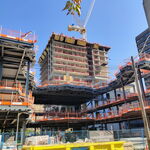Toronto’s deputy mayor is pushing for the city to set clear targets for the pilot project that would prioritize streetcars over car traffic on King St., in order to prevent its supporters from “declaring victory” without any clear evidence.
As expected, the TTC board voted Thursday to move ahead with the pilot, which would
restrict private car movement on King.
With daily ridership of 65,000 people, the 504 King streetcar is the TTC’s busiest surface transit route, but its movement through the downtown core is severely impeded by the 20,000 drivers that use the street every day.
The pilot, which would be installed between Bathurst and Jarvis Sts., will now go to Mayor John Tory’s executive committee next Monday, where it’s expected to be approved and sent to council next month for a final vote.
While endorsing the pilot, commissioners also approved a motion moved by board member Deputy Mayor Denzil Minnan-Wong that asked staff to develop “benchmarks for success” for the project and report to the board by the end of 2017.
Minnan-Wong voted in favour of the pilot. But he argued that, without clear measurements in place at its start, its supporters on council and in the city bureaucracy could simply deem it a success no matter what data comes back.
“You decide what a win looks like before you start. You don’t define the win based on the data that you get,” he said.
“The pilot project is supposed to achieve certain things . . . . Let’s set what those levels are going to be now, and then let’s do the pilot project and see if those things are achieved.”
The motion didn’t specify which benchmarks should be used or how specific the targets should be. Minnan-Wong said he would leave that up to city staff.
TTC chair Josh Colle said staff have already devised several metrics by which to gauge the project. They include its effect on economic activity, traffic, and the reliability of streetcar service.
But Colle said he didn’t object to more clearly laying out the criteria. He stated that he was confident the pilot will be a success, and that the primary measure should be whether transit service improves.
“We have to look at business continuity and safety and all those other things, but, to me, the whole point of all of this is to move those 65,000 people more quickly,” he said.
He rejected the idea that Minnan-Wong’s motion could turn out to be a poison pill that would give critics of the project a chance to sink it if it didn’t meet certain targets.
“If anything, I think the case is going to be so compelling, it will just give further validation to why this was so badly needed.”
The board also approved a motion tabled by Councillor Joe Mihevc that asked the city and TTC to consider extending the pilot project further along King and replicating it on “the central portion of other downtown major arterials” as part of the project evaluation.
Colle said that only made sense. “We should look at every one of our streetcar corridors this way. If we don’t use this data for that, we’ve kind of missed out.”
If approved by council, the $1.5-million pilot on King would be installed in late fall and run for at least one year.




